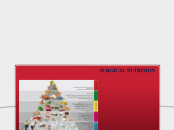SURGICAL NUTRITION
Peyton Lloyd Lawrence
SUPPORT STRATEGIES
principle
- supply caloric requirement to preserve lean mass, promote good
immunologic function and wound healing WHILST AVOIDING
OVERFEEDING
QUANTITY
objectively - depends on total caloric requirement determined by assessment (BMR, REE, direct)
rough estimates - maintenance = 25-30kca/kg/dy
weight gain- 30-40kcal/kg/day
principle for TPN mixing - minus protein contribution from
total caloric requirement and make up the rest with DW and Lipid
usually in a 20:50:30 ratio (pro:carb:fat)
QUALITY
-EN
- Gastric+ Duodenal - bolus non elemental feed, Slow
- Jejunal - elemental- (no brush border enteropeptidases to monomers)
- Dx specific e.g. Glucerna - DM; Nepro- CKD; Vivonex - Burns
- Immune enhancing - Oxepro; Crucial
PN
- 2 in 1, 3 in 1 mixes or single (varying concentrations)
- immune enhancing - incr glutamine; arginine
- antinflammatory - omega 3 (eicospantaeoate)
instead of omega 6 (linoleiate) based
Townsend, Courtney M. Jr, Beauchamp, Daniel R; Evers, Mark B and Mattox, Kenneth L 2010. Sabiston Textbook of Surgery. 19th ed. Canada: Elsevier
COMMENCEMENT TIME (early vs delayed)
Early usually preferred
Optimise to anabolic state before surgery
Preop weight loss 0f 10-20% intentional for obese pts
Early postop - fast track surgery
Early enteral even in Pancreatitis
Townsend, Courtney M. Jr, Beauchamp, Daniel R; Evers, Mark B and Mattox, Kenneth L 2010. Sabiston Textbook of Surgery. 19th ed. Canada: Elsevier
ROUTE (EN vs PN)
Enteral preferred - more physiologic:-
- prevents mucosal atrophy = prevents
bacterial translocation
- propagates Portal circulation and hepatic function
*Blind/ Endoscopic (<4/52) or Surgical (>4/52)
Parenteral- only if EN is contraindicated or
insufficient to handle requirements.
OBESITY PARADOX
TRADITIONAL THOUGHTS
Obesity associated with:
- increased Anaesthetic and Surgical complications e.g. Thromboembolic phenom; Wound sepsis and cardiovascular events
weight loss confers benefits of decreased incidence of metabolic syndrome and bertter perioperative outcome
Sjöström, L., Lindroos, A.K., Peltonen, M., et al. (2004) Lifestyle, diabetes, and cardiovascular risk factors
10 years aft er bariatric surgery. New England Journal of Medicine , 351 , 2683–93.
ref [3], [4] [19]
paradox is not well understood but thought that
obese states confer more physiological reserves for
times of hypermetabolic demand
Survival
Conclusion
Appproach to nutrition in the perioperative is evolving as
our understanding of Claude Bernard's internal milieu (homeostasis) grows.
The results seen in fast track surgery and the observations of the Obesity Paradox substantiate the views that "a little extra physiological reserves" confers a mortality advantage!
References
1. Townsend, Courtney M. Jr, Beauchamp, Daniel R; Evers, Mark B and Mattox, Kenneth L 2010. Sabiston Textbook of Surgery. 19th ed. Canada: Elsevier
2. Sjöström, L., Lindroos, A.K., Peltonen, M., et al. (2004) Lifestyle, diabetes, and cardiovascular risk factors
10 years aft er bariatric surgery. New England Journal of Medicine , 351 , 2683–93.
3. Fonarow GC, Srikanthan P, Costanzo MR, Cintron GB, Lopatin
M. ADHERE Scientific Advisory Committee and Investigators.
An obesity paradox in acute heart failure: analysis of body mass index and inhospital mortality for 108,927 patients in the Acute Decompensated Heart Failure National Registry. Am Heart J. 2007;153:74–81.
4. Uretsky S, Messerli FH, Bangalore S, Champion A, Cooper-DeHoff
RM, ZhouQ, et al. Obesity paradox in patients with hypertension and
coronary artery disease. Am J Med. 2007;120:863–70.
5. Doehner W, Erdmann E, Cairns R, Clark AL, Dormandy JA,
Ferrannini E, Anker SD. Inverse relation of body weight and
weight change with mortality and morbidity in patients with type
2 diabetes and cardiovascular co-morbidity: an analysis of the
PROactive study population. Int J Cardiol. 2011. doi:10.1016/j.
ijcard.2011.09.039.
ASSESSMENT
PRINCIPLE IS IDENTIFYING MALNUTRITION THEN,
CLASSIFYING TYPE AND STRATIFYING SEVERITY,
WITH THE VIEW TO DEVICE AN APPROPRIATE SUPPORT STRATEGY
CALORIMETRY
1. Energy expenditure equations
BMR - HARRIS BENEDICT,
Stressed state = CURRERI- GALVESTON e.g.Burns pts)
2. Resting energy Expenditure = (RQ from ventilator)
3. DIRECT-using calorimeter
Townsend, Courtney M. Jr, Beauchamp, Daniel R; Evers, Mark B and Mattox, Kenneth L 2010. Sabiston Textbook of Surgery. 19th ed. Canada: Elsevier
BLOOD
- serum proteins (Alb, Transferrin,
Prealbumin, RBP)
- TLC (%lymph / WBC)
- CBC , U&E
NITROGEN BALANCE = N(g) intake minus 24hr UN
BODY COMPOSITION ASSAY
- Dual Xray ABsorptiometry
compares differential tissue xray
absorption to standardised norms
- gives relative values for lean mass,
fat and bone
Townsend, Courtney M. Jr, Beauchamp, Daniel R; Evers, Mark B and Mattox, Kenneth L 2010. Sabiston Textbook of Surgery. 19th ed. Canada: Elsevier
ANTHROPOMETRY
1. WEIGHT MEASURES- % wgt loss,
BMI, IBW
2. SKIN FOLD THICKNESS - MAC, TSF
CLINICAL
HISTORY
- Weight and dietary changes over time
- Catabolic factors (comorbidity, Rx, recent stress, GI disease, Anorexia nervosa or bulimia)
- Anabolic factors (insulin / GH use, eating disorder, family hx or genetic mutation- leptin and melancortin-r)
PHYSICAL EXAM
- General- wasting + mucocutaneous lesions
- Specific: abdomen, cardiopulmonary
Townsend, Courtney M. Jr, Beauchamp, Daniel R; Evers, Mark B and Mattox, Kenneth L 2010. Sabiston Textbook of Surgery. 19th ed. Canada: Elsevier

